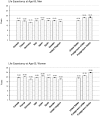Survival differences among native-born and foreign-born older adults in the United States
- PMID: 22615929
- PMCID: PMC3353911
- DOI: 10.1371/journal.pone.0037177
Survival differences among native-born and foreign-born older adults in the United States
Abstract
Background: Studies show that the U.S. foreign-born population has lower mortality than the native-born population before age 65. Until recently, the lack of data prohibited reliable comparisons of U.S. mortality by nativity at older ages. This study provides reliable estimates of U.S. foreign-born and native-born mortality at ages 65 and older at the end of the 20(th) century. Life expectancies of the U.S. foreign born are compared to other developed nations and the foreign-born contribution to total life expectancy (TLE) in the United States is assessed.
Methods: Newly available data from Medicare Part B records linked with Social Security Administration files are used to estimate period life tables for nearly all U.S. adults aged 65 and older in 1995. Age-specific survival differences and life expectancies are examined in 1995 by sex, race, and place of birth.
Results: Foreign-born men and women had lower mortality at almost every age from 65 to 100 compared to native-born men and women. Survival differences by nativity were substantially greater for blacks than whites. Foreign-born blacks had the longest life expectancy of all population groups (18.73 [95% confidence interval {CI}, 18.15-19.30] years at age 65 for men and 22.76 [95% CI, 22.28-23.23] years at age 65 for women). The foreign-born population increased TLE in the United States at older ages, and by international comparison, the U.S. foreign born were among the longest-lived persons in the world.
Conclusion: Survival estimates based on reliable Medicare data confirm that foreign-born adults have longer life expectancy at older ages than native-born adults in the United States.
Conflict of interest statement
Figures



Similar articles
-
Life Expectancy Among U.S.-born and Foreign-born Older Adults in the United States: Estimates From Linked Social Security and Medicare Data.Demography. 2016 Aug;53(4):1109-34. doi: 10.1007/s13524-016-0488-4. Demography. 2016. PMID: 27383845 Free PMC article.
-
Racial/Ethnic and Nativity Differences in Cognitive Life Expectancies Among Older Adults in the United States.Gerontologist. 2019 Mar 14;59(2):281-289. doi: 10.1093/geront/gnx142. Gerontologist. 2019. PMID: 28958071 Free PMC article.
-
Physical and mental health characteristics of U.S.- and foreign-born adults: United States, 1998-2003.Adv Data. 2006 Mar 1;(369):1-19. Adv Data. 2006. PMID: 16541709
-
Nativity and Country of Origin Variations in Life Expectancy With Functional Limitations Among Older Hispanics in the United States.Res Aging. 2020 Aug;42(7-8):199-207. doi: 10.1177/0164027520914512. Epub 2020 Apr 2. Res Aging. 2020. PMID: 32238009
-
International Differences in Mortality at Older Ages: Dimensions and Sources.Washington (DC): National Academies Press (US); 2010. Washington (DC): National Academies Press (US); 2010. PMID: 21977541 Free Books & Documents. Review.
Cited by
-
Obesity Among U.S.- and Foreign-Born Blacks by Region of Birth.Am J Prev Med. 2015 Aug;49(2):269-73. doi: 10.1016/j.amepre.2015.02.014. Epub 2015 Apr 18. Am J Prev Med. 2015. PMID: 25896192 Free PMC article.
-
Life Expectancy Among U.S.-born and Foreign-born Older Adults in the United States: Estimates From Linked Social Security and Medicare Data.Demography. 2016 Aug;53(4):1109-34. doi: 10.1007/s13524-016-0488-4. Demography. 2016. PMID: 27383845 Free PMC article.
-
Disparities in the Prevalence and Correlates of Disability in Older Immigrants in the USA: a Systematic Review of the Literature.J Racial Ethn Health Disparities. 2019 Jun;6(3):552-562. doi: 10.1007/s40615-018-00554-9. Epub 2019 Jan 7. J Racial Ethn Health Disparities. 2019. PMID: 30618007 Free PMC article.
-
Do Immigrants' Health Advantages Remain After Unemployment? Variations by Race-Ethnicity and Gender.J Soc Issues. 2022 Sep;78(3):691-716. doi: 10.1111/josi.12463. Epub 2021 Jun 27. J Soc Issues. 2022. PMID: 36278121 Free PMC article.
-
Disparities in exposure to surrounding greenness related to proportion of the population that were immigrants to the United States.Int J Hyg Environ Health. 2020 Mar;224:113434. doi: 10.1016/j.ijheh.2019.113434. Epub 2019 Dec 18. Int J Hyg Environ Health. 2020. PMID: 31978731 Free PMC article.
References
-
- United Nations. Department of Economic and Social Affairs, Population Division. United Nations, New York; 2009. World Population Prospects 2008 Revision.
-
- World Health Organization website. 5 Available: http://apps.who.int/whosis/database/life_tables/life_tables.cfm. Accessed 2010 November.
-
- Manton KG, Vaupel JW. Survival after the age of 80 in the United States, Sweden, France, England, and Japan. N Engl J Med. 1995;333:1232–1235. - PubMed
-
- Larsen LJ. Current population reports. U.S. Census Bureau, Washington, DC. ; 2003. The foreign-born population in the United States: 2003. pp. P20–551.
-
- Lollock L. Current population reports. U.S. Census Bureau, Washington, D.C. ; 2001. The foreign born population in the United States: March 2000. pp. P20–534.
Publication types
MeSH terms
Grants and funding
LinkOut - more resources
Full Text Sources

